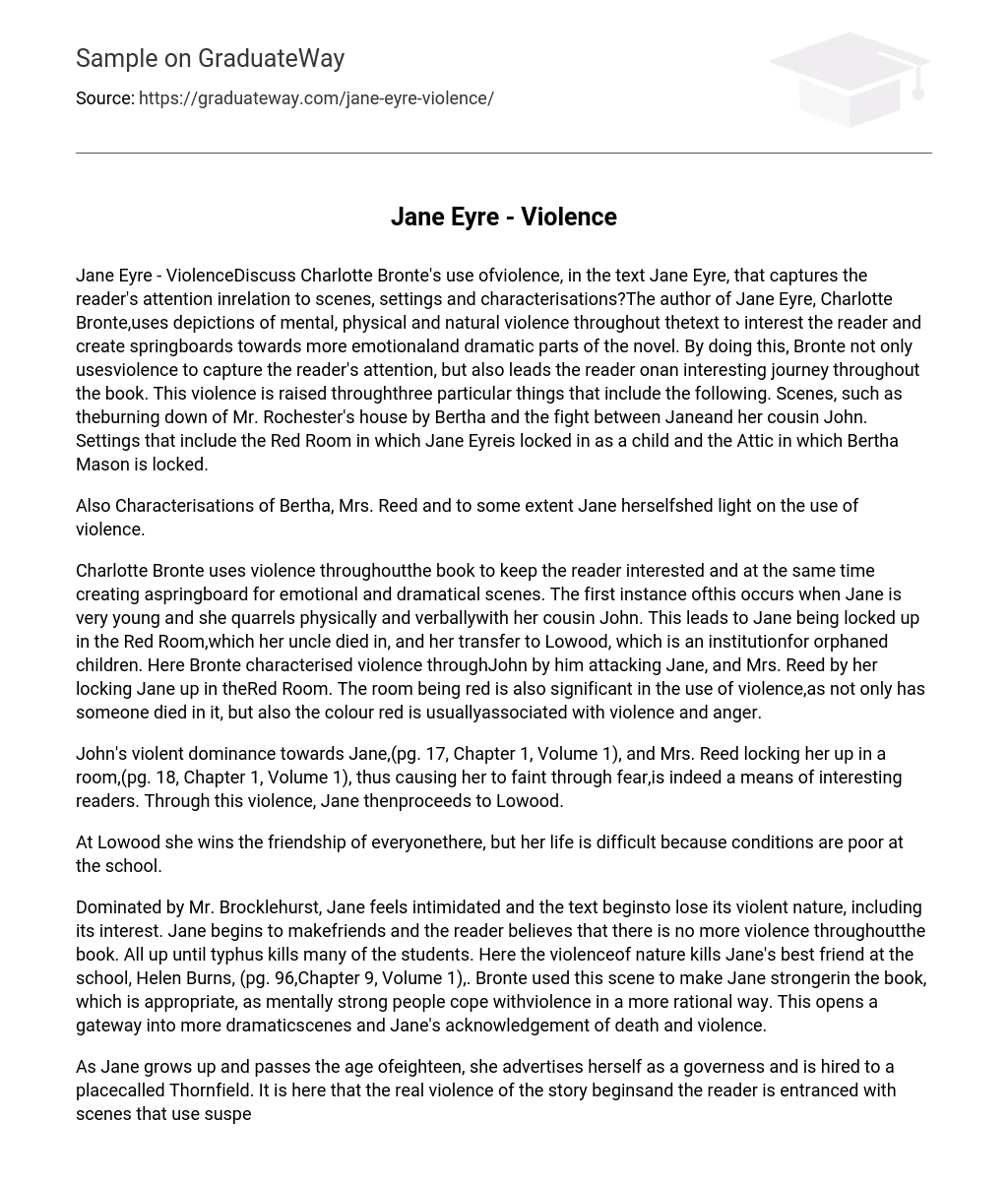The author of Jane Eyre, Charlotte Bronte, uses depictions of mental, physical and natural violence throughout thetext to interest the reader and create springboards towards more emotionaland dramatic parts of the novel. By doing this, Bronte not only usesviolence to capture the reader’s attention, but also leads the reader onan interesting journey throughout the book. This violence is raised throughthree particular things that include the following.
Scenes, such as theburning down of Mr. Rochester’s house by Bertha and the fight between Janeand her cousin John. Settings that include the Red Room in which Jane Eyreis locked in as a child and the Attic in which Bertha Mason is locked. Also Characterisations of Bertha, Mrs. Reed and to some extent Jane herselfshed light on the use of violence.
Charlotte Bronte uses violence throughoutthe book to keep the reader interested and at the same time creating aspringboard for emotional and dramatical scenes. The first instance ofthis occurs when Jane is very young and she quarrels physically and verballywith her cousin John. This leads to Jane being locked up in the Red Room,which her uncle died in, and her transfer to Lowood, which is an institutionfor orphaned children. Here Bronte characterised violence throughJohn by him attacking Jane, and Mrs. Reed by her locking Jane up in theRed Room. The room being red is also significant in the use of violence,as not only has someone died in it, but also the colour red is usuallyassociated with violence and anger.
John’s violent dominance towards Jane,(pg. 17, Chapter 1, Volume 1), and Mrs. Reed locking her up in a room,(pg. 18, Chapter 1, Volume 1), thus causing her to faint through fear,is indeed a means of interesting readers. Through this violence, Jane thenproceeds to Lowood. At Lowood she wins the friendship of everyonethere, but her life is difficult because conditions are poor at the school.
Dominated by Mr. Brocklehurst, Jane feels intimidated and the text beginsto lose its violent nature, including its interest. Jane begins to makefriends and the reader believes that there is no more violence throughoutthe book. All up until typhus kills many of the students. Here the violenceof nature kills Jane’s best friend at the school, Helen Burns, (pg. 96,Chapter 9, Volume 1),
Bronte used this scene to make Jane strongerin the book, which is appropriate, as mentally strong people cope withviolence in a more rational way. This opens a gateway into more dramaticscenes and Jane’s acknowledgement of death and violence. As Jane grows up and passes the age ofeighteen, she advertises herself as a governess and is hired to a placecalled Thornfield. It is here that the real violence of the story beginsand the reader is entranced with scenes that use suspense to ensure thereader’s enjoyment of the book.
Obviously Bronte knew that a thriller(violence that is not fully revealed till the latter part of the book)is a significant way to keep readers interested. So she writes a scenewhere someone (Mr. Mason) is mysteriously stabbed (pg. 236, Chapter 5,Volume 2), and doesn’t enlighten the reader on who did it but does hintthat someone else (Mr. Rochester) knows. There is no way of knowing whythis happened, who does it, or if Mr. Mason is going to live or die. Thatis why Charlotte Bronte used violence to create this kind of suspense. So a person would be interested enough in the novel to keep reading.
The mystery is a mystery itself, thereis a secret at Thornfield and Jane can sense this. Then there is the mysteryof the person who committed this act of violence. Jane suspects who itmight be, but she is not for sure. To find out the mystery of the houseand the person who did it is a wise way to capture a reader’s attention.
As the story unfolds, the reader finds out about a lady named Bertha, whois Rochester’s original wife, and a character that strives on violent acts. This is the part of the book that exclaimsthat every character has violence, and if read carefully how very closeJane is to Bertha. Jane describes Bertha as a ghost or a vampire afterthe wedding veil is torn (pg. 316, Chapter 10, Volume 2).
Mr. Rochestersimilarly thinks of Jane as a spirit and witch. Bertha scratches and bite,and Jane scratches her cousin John Reed. Bertha is tied to a chair andlocked in the attic, whilst Jane was told to sit in her chair and is lockedin the Red Room. This certifies that when Jane follows her passions andloses her self-control she behaves and is punished like Bertha, thereforecreating violence.
Perceptively, the novel Jane Eyre is basedparticularly around the depictions of violence as to grab the reader’sattention. Charlotte Bronte’s views on the Victorian woman are indeednot of what they were supposed to be. Therefore she wrote this story toshow everyone how women should see themselves and how they should be treatedno matter the cost. Her problem was not to translate her contention, butkeep the reader interested. She therefore used violence throughout thenovel and within scenes, settings and characters as she pleased to makeJane Eyre a story of a woman’s dramatic journey through life depictingdominance and violence.





